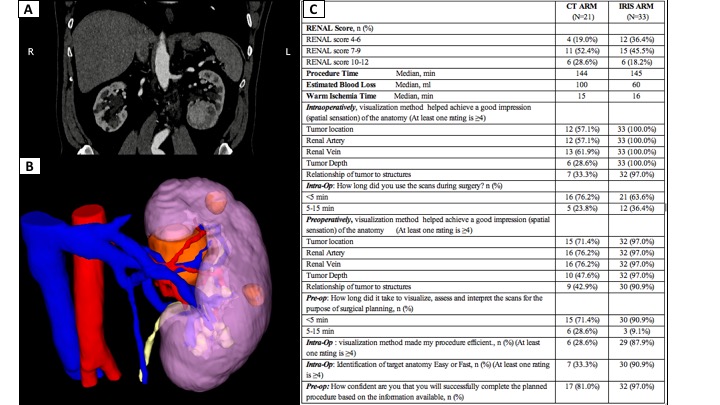Back
Poster, Podium & Video Sessions
Best Poster Award
MP50: Kidney Cancer: Localized: Surgical Therapy III
MP50-17: Prospective comparative study to evaluate the clinical utility of IRIS 3-D anatomical modeling software for Preoperative Surgical Planning and Intra-operative navigation for Robot Assisted Partial Nephrectomy (RAPN): A preliminary analysis
Sunday, May 15, 2022
4:30 PM – 5:45 PM
Location: Room 225
Ahmed Ghazi*, Rochester, NY, Tanner Corse, Hackensack, NJ, Thomas Osinski, Thomas Frye, William Tabayoyong, Rochester, NY, Linda Dayan, Ravi Munver, Hackensack, NJ, Hani Rashid, Jean Joseph, Rochester, NY, Michael Stifelman, Hackensack, NJ

Ahmed E. Ghazi, MD, FEBU, MBBS
University of Rochester
Poster Presenter(s)
Introduction: The objective of the study was to evaluate the clinical utility of IRIS (Intuitive Surgical Inc., Sunnyvale, CA, USA) with CT scans in comparison to CT scan alone for preoperative surgical planning and intraoperative navigation during RAPN.
Methods: This is a prospective, multi-center, post-market study (NCT04329767) with 54 currently enrolled RAPN patients. Patients were randomized into two groups with preoperative surgical planning and intraoperative navigation using either CT scans alone (N=21) or IRISTM with CT scans (N=33). Demographic and intraoperative data were collected and analyzed. A 5-point Likert-type scale evaluated the impact of each modality on anatomy interpretation, confidence completing the procedure and procedure efficiency was evaluated for every case. Overlap between the preoperative planned clamping and the actual operative clamping was evaluated.
Results: Results are summarized in Table 1. Tests of significance were not performed in this interim analysis of an ongoing trial.
Higher incidence of surgeons in IRIS arm (97%) vs CT arm (81%) reported confidence in successfully completing the planned RAPN procedure. During intraoperative navigation, surgeons rated (>4) that all IRIS cases achieved good spatial sensation of the anatomy compared to CT cases (100% vs 76%). This was most enhanced in patients (6 vs 6) with RENAL score 10-12 , where a 50-80% increase in anatomical interpretation of various critical structures was reported using IRIS. Surgeons preoperatively reviewing IRIS reported higher confidence in performing zero or selective vs global ischemia which translated to higher actual execution in IRIS (39%) vs CT arm (9.5%).
Intraoperatively IRIS demonstrated improved procedure efficiency in 88% of cases vs. 29% in the CT arm, mainly attributed to ease in interpreting anatomy in the IRIS arm (91% vs 33%).
Conclusions: In this pilot study comparing the utility of IRIS to standard 2D imaging during RAPN, IRIS improved self-reported surgeon confidence, efficiency, and complex anatomical interpretation particularly during complex RAPN cases with increased incidence of non-global ischemia approaches.
Source of Funding: Intuitive Research Grant

Methods: This is a prospective, multi-center, post-market study (NCT04329767) with 54 currently enrolled RAPN patients. Patients were randomized into two groups with preoperative surgical planning and intraoperative navigation using either CT scans alone (N=21) or IRISTM with CT scans (N=33). Demographic and intraoperative data were collected and analyzed. A 5-point Likert-type scale evaluated the impact of each modality on anatomy interpretation, confidence completing the procedure and procedure efficiency was evaluated for every case. Overlap between the preoperative planned clamping and the actual operative clamping was evaluated.
Results: Results are summarized in Table 1. Tests of significance were not performed in this interim analysis of an ongoing trial.
Higher incidence of surgeons in IRIS arm (97%) vs CT arm (81%) reported confidence in successfully completing the planned RAPN procedure. During intraoperative navigation, surgeons rated (>4) that all IRIS cases achieved good spatial sensation of the anatomy compared to CT cases (100% vs 76%). This was most enhanced in patients (6 vs 6) with RENAL score 10-12 , where a 50-80% increase in anatomical interpretation of various critical structures was reported using IRIS. Surgeons preoperatively reviewing IRIS reported higher confidence in performing zero or selective vs global ischemia which translated to higher actual execution in IRIS (39%) vs CT arm (9.5%).
Intraoperatively IRIS demonstrated improved procedure efficiency in 88% of cases vs. 29% in the CT arm, mainly attributed to ease in interpreting anatomy in the IRIS arm (91% vs 33%).
Conclusions: In this pilot study comparing the utility of IRIS to standard 2D imaging during RAPN, IRIS improved self-reported surgeon confidence, efficiency, and complex anatomical interpretation particularly during complex RAPN cases with increased incidence of non-global ischemia approaches.
Source of Funding: Intuitive Research Grant


.jpg)
.jpg)